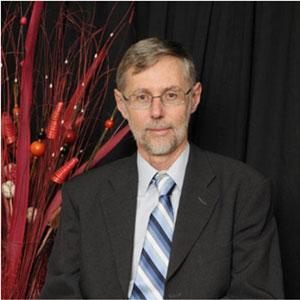 Mike Gaylard. Photo courtesy of Ludwig Combrinck
Mike Gaylard. Photo courtesy of Ludwig Combrinck
Mike Gaylard
Contributed by Ludwig Combrinck
Mike Gaylard, Director of the Hartebeesthoek Radio Astronomy Observatory (HartRAO), was born in July 1952, and died in August 2014. He joined the staff of HartRAO on 1 December 1976, after having graduated in November 1976 with an MSc degree, from Rhodes University, on "The Performance of a 22 GHz Radio Telescope". His initial work at HartRAO was in the field of HII regions and recombination lines at 2.3 GHz. He completed his PhD on "Radio Studies of Ionized Hydrogen in the Southern Milky Way", using the HartRAO 26m telescope, in 1989. His work branched out into the field of 1612 MHz OH masers with the installation of the 18cm receiver in 1985. His field of work then expanded to include methanol masers in star forming regions, where he collaborated extensively with Gordon Macleod (then of HartRAO) and Johan van der Walt of North West University. With the increase in the staff complement at HartRAO, he was appointed leader of the Spectral Lines Program and had more than 70 publications to his name. He supervised MSc and PhD students, especially with van der Walt at NWU, and then expanded to other universities as well. A number of research staff members from HartRAO later went on to become part of the SKA project.
He also headed the Science Awareness Outreach Program at HartRAO. Creating an awareness of science in young people was one of his passions and several staff members from the HartRAO Science Awareness Program also went on to join the SKA project.
Mike was instrumental in the conception of the African Very Long Baseline Interferometry (VLBI) Network (AVN), a vision to have a network of radio astronomy telescopes throughout Africa, and actively participated in and championed its development. The AVN has the potential to spread radio astronomy as a science across the African continent.
He was among the key people who helped get the National Astronomy and Space Science Program (NASSP) started. The NASSP school at HartRAO was something he enjoyed organizing and which has helped introduce a generation of South African astronomers to the practicalities of radio observing. He also understood that South African astronomers would do so much better working together than as individuals.
In an international context, Mike was the driving force behind South Africa's membership of the Joint Institute for VLBI in Europe (JIVE), which carries out a wide range of research and development activities in VLBI-related fields, including radio astronomy data processing and applications of VLBI and radio astronomy technologies.
Mike Gaylard had the ability to make time to talk to and encourage students, even with a very busy schedule. To many young people he set a great example as a leader and a scientist.
![[IAU logo]](iau_wb_thumb.jpg)
![[URSI logo]](URSI-logo-thumb.jpg)
![[Karl Jansky at his antenna]](jansky_photo_02_thumb.jpg)
![[Reber's Wheaton antenna]](Reber_Telescope_Wheaton_thumb.jpg)
![[Dover Heights]](Dover_Heights_02_thumb.jpg)
![[4C telescope]](GB61-195_4C_telescope_thumb.jpg)
![[Ewen and horn antenna]](ewen_horn1s.jpg)
![[Dwingeloo, 1956]](Dwingeloo-1956-thumb.jpg)
![[Jocelyn Bell Burnell and Cambridge antenna used in pulsar discovery]](burnell2_thumb.jpg)
![[Lovell Telescope at Jodrell Bank]](site_1594_0001-500-334-20180316163019-thumb150.jpg)
![[Wilson, Penzias, and Bell Labs horn antenna]](wilson-penzias-horn_thumb.jpg)
![[6-m Millimeter Radio Telescope in Mitaka, Japan]](6m-thumb.jpg)

